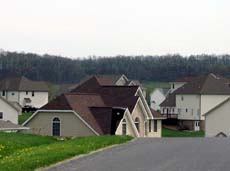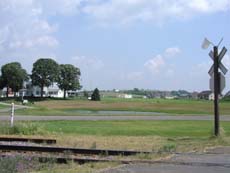index
Sprawl Outline
click on images for full-size:





New subdivision in Virginia

New houses infiltrating Wisconsin countryside

Suburban Virginia McMansion

Sprawl traffic
- Suburbs have been with us for a long time, and changing all the while.
- Now they sprawl out of control, and receive their share of sharp criticisms.
- Many of the criticisms presume a classic notion of closed places.
- Sprawl is supposed to destroy the human qualities of dense urbanism.
- Has the traditional city has come to an end?
- Most cities are losing their economic centrality, so what are cities for?
- Are the virtues of urban density transplantable to the sprawl? Discussions of:
- Jane Jacobs on the size of economic communities.
- Manuel Castells on the need for mega-cities.
- Mario Gandelsonas on the creativity of urban density.
- Richard Sennett on cities as fostering democracy.
- Henre Lefebvre on centralized urban form.
- The place form of suburban sprawl is more complex than its spatial and architectural form, and more complex than the usual criticisms perceive. Architectural and planning improvements should take account of that more complex place form, with its new possibilities and directions, and not work with a too simple model.
- What can be done when creating new communities?:
- The New Urbanism is a much discussed mode of forming centered communities, with results that are more complex than they might appear to be.
- There are opposite visions of dispersed, decentered communities, such as Frank Lloyd Wright's Broadacre City and its descendants.
- What can be done to retrofit the existing sprawl, where most people live? How to make its architectural and spatial form reflect its place form?
- Interventions within the current structures might increase linkage and self-awareness of joinings and connections.
- "Smart growth" measures can bring some benefits.
- More radical interventions might change the standard notions or laws about property rights.
- Retrofits will not make a classic aesthetic whole out of suburbia. Nor should they.
- There are some dangers in this attempt to improve suburbia through more complexity and linkage:
- Shouldn't we aim to change everything about sprawl development?
- Attempts to increase complexity might lead to too much homogeneity. Yet what is visually or architecturally homogeneous might not be lived homogeneously.
- Improving (and wiring) suburbia could worsen problems of equity and justice.